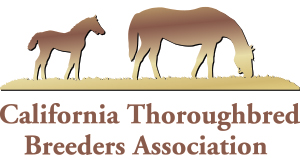By Jay Hovdey, DRF.com
COALINGA, Calif. (July 10, 2014) — Art Sherman leaned down and braced himself against the right front leg of California Chrome, lifted the colt’s foot, and peeled off the white bell boot protecting the hoof. California Chrome shifted his weight.
“Easy boy,” Sherman said.
California Chrome complied and allowed Sherman to take a good look at the back of the foot. The trainer ran his thumb over a barely visible scar line just above the coronet band.
“It’s gone,” Sherman said. “You can’t hardly see it at all.”
It had been 32 days since California Chrome had gotten that right front foot tangled with the hooves of longshot Matterhorn at the start of the Belmont Stakes, and now here he was, in one of the roomy, tree-shaded grass paddocks reserved for the stallions at Harris Farms in California’s drought-stricken Central Valley. His copper coat was flecked with dirt and he was working on a mouthful of carrot, courtesy of farm manager Dave McGlothlin at the shank.
“He was clean when we turned him out, but he loves to roll – over there, and there,” McGlothlin said, pointing to a couple of well-worn spots along the paddock fence. “He’s enjoying it so much now it’s getting harder to catch him unless you bring some bait.”
Isolated as an island of Thoroughbreds in a vast countryside of beef cattle and agriculture, Harris Farms still is a linchpin of the California breeding business and home to such stallions as Unusual Heat, the California leader, and Lucky Pulpit, sire of California Chrome, who was born at Harris Farms. Among its residents is Love the Chase, the dam of California Chrome, along with her yearling and weanling fillies.
Sherman gently lowered California Chrome’s foot and backed away to enjoy the view. California Chrome had been at Harris Farms since June 19 for some R&R after the rigors of the Triple Crown campaign, and Sherman had not seen him since.
“I’m really pleased about the way that cut’s healed,” Sherman said. “I pushed on it a little and got nothing from him at all.”
The cut was one of several things that did not go well for California Chrome in the Belmont, depriving him of making history as the 12th winner of the Triple Crown for owners Perry Martin and Steve Coburn. The start was rough, the trip was cramped down the backstretch and wide on the turn, but at the end of the 1 1/2 miles the cold fact remained that three horses ran faster.
Sherman took a deep breath after the Belmont and decided the Triple Crown was not meant to be. He would have to settle for his colt winning the Kentucky Derby and the Preakness. At 77, the trainer could live with that.
“Looking back, there were a bunch of little things not going quite right that might have added up,” Sherman said. “One thing everybody noticed was that he wasn’t acting the same in the paddock in New York as he did before the Derby and the Preakness.”
Let the tittering begin. Horses, as everyone must know by now, compete without pants. This means that a stallion may, on occasion, forget he is in full public view and indulge himself with an erection, which leads to no end of lame cracks and snickers, from horsemen and fans alike. California Chrome was on display before going postward at the Derby and again at the Preakness.
“Bob Baffert said something to me watching him at Pimlico,” Sherman said. “I told him, ‘Bob, before you say anything else you should know I’m wearing a microphone from NBC.’ ”
Whether or not California Chrome’s prerace studdishness had anything to do with his impressive victories in Louisville and Baltimore is unknown. They test for TCO2, not blood flow.
In the Belmont paddock, however, all was quiet. Sherman did not minimize (yes, I wrote that) the change in California Chrome’s demeanor.
“You get used to everything about a horse when everything is right,” Sherman said. “For whatever reason he was different that day in that one respect.”
As if to reassure his trainer all was well, standing there in the warm Central Valley sun, California Chrome proudly unfurled the flag. Sherman laughed, shook his head, and changed the subject.
“You can see he’s put on a little weight in the belly, but I expected that,” the trainer said. “Especially since they tell me he doesn’t do much running around. He appears to be taking the idea of a vacation seriously.”
After Sherman consulted with McGlothlin and farm trainer Per Antonsen, it was decided that California Chrome would return to the Sherman stable at Los Alamitos the following week. There the colt will prepare for a two-race fall campaign that would include something at the end of September – perhaps even a race at Los Alamitos – followed by the Breeders’ Cup Classic at Santa Anita Park on Nov. 2.
Sherman concluded his visit with an affectionate stroke of the colt’s neck and then, as he headed for the paddock gate, one last appreciative look at his double classic winner.
“Would you look at that,” Sherman said. “The Kentucky Derby winner, out here in the middle of nowhere.”
“Want to see his little sister?” McGlothlin asked.
“You mean the Kentucky Oaks winner?” Sherman said. “Lead the way.”

